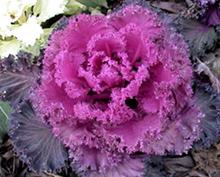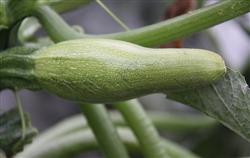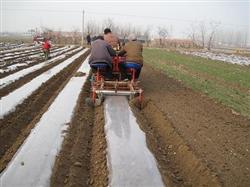Cultivation techniques of purple cabbage

1 cultivation time in spring, seedlings are generally raised in greenhouse at the end of January and planted in the open field at the end of March. (2) the main varieties suitable for protected cultivation in spring are Zigan 1, Zaohong, Hongmu, Tehong 1 and so on. (3) the ability of absorbing fertilizer of purple cabbage by soil preparation is strong. The land should be ploughed deeply, leveled and made into a border with a width of 1 to 1.2 meters. 5000 kg of organic fertilizer, 25kg of phosphate fertilizer, 30kg of urea and 20kg of potash fertilizer were applied every 667m2. Purple cabbage plant calcium content is second only to nitrogen, such as calcium deficiency will produce dry heartburn, so it is necessary to properly supplement part of the calcium fertilizer. 4Seedling purple cabbage is generally cultivated by seedling raising and transplanting. When raising seedlings and sowing, sowing is used, and the seed amount is 50g / 667 square meters. After emergence, the temperature of cotyledon stage was 15: 20 ℃, and that of true leaf stage was 18-22 ℃. It was gradually close to the external temperature 5-7 days before planting. Spring sowing purple cabbage was planted in the open field at the end of March and the beginning of April. Sitting water planting is beneficial to improve the ground temperature and slow down the seedlings. The plant-row spacing of early-maturing varieties was 50 cm × 50 cm, 2500 plants per 667m ~ 2, and that of middle-mature varieties was 59cm × 60cm, 2200 plants per 667m ~ 2. (5) the growth period of purple cabbage under field management can be divided into seedling stage, rosette stage and heading stage. 5Prior 1 Seedling Management before sowing, the seedbed should be thoroughly watered, split seedlings and fixed planting should be watered thoroughly to avoid root injury. In addition, try not to water. 5The rosette stage was managed by watering slow seedling water for 1 and 2 times and then entering the squatting seedling stage, during this period, the seedlings were ploughed for 2-4 times. The first intertillage should be deep and comprehensive, in order to preserve soil moisture and promote root growth; in the middle of the rosette, shallow ploughing should be combined with soil cultivation to promote short stems and more roots, which is conducive to heading. It takes 15 days for early-maturing varieties to squat seedlings and 30 days for late-maturing varieties to squat seedlings. When you begin to bear balls at the end of rosette, you should irrigate a lot of water. 5. Management of heading period during this period, the leaf bulb grows fast and needs a lot of water, and the ground is generally watered as soon as it is dry until harvest. (6) the harvest can be achieved in real time when the leaf ball reaches quite tight. Cut off the root pedicel during harvest, remove the outer leaves and damaged leaves, so that the leaf ball is clean and free of soil. Early-maturing varieties can be harvested in batches as long as the leaf balls have a certain degree of compactness in order to be put on the market earlier. It can be collected within 1 month. Mid-and late-maturing varieties generally have to wait for the bulb to grow to the largest and tightest real-time concentration for 1 to 2 times. The yield of early-maturing varieties can reach 2000 kg per square meter, while that of medium-maturing and late-maturing varieties can reach 3000-4000 kg per square meter. (7) Prevention and control of diseases and insect pests. (7) in the seedling stage, the occurrence of quenching disease should be prevented, moisture should be properly controlled, ventilation and light should be more transparent. In the heading period, mainly to prevent the occurrence of soft rot, especially in summer and autumn, to prevent stagnant water, diseased plants should be pulled out in time. Spraying with 100mg / kg agricultural streptomycin has a certain control effect. At the same time, the burning edge phenomenon is easy to occur in the heading period, so it is necessary to maintain the soil moisture to facilitate the absorption of calcium. In addition, but also in the foliar spray some calcitonin also has a certain prevention and control effect. 7. Insect pests are mainly aphids and cabbage insects. The control method of aphids is to remove weeds, residual plants and dead leaves in time. It can be controlled by 40% dimethoate EC, 50% anti-aphid fog wettable powder and quick-killing dimethrin and other agents. The control method of Pieris rapae is to avoid continuous cropping or interplanting with vegetables of the same family. Chemical control can be controlled by 2.5% Kung Fu EC or bt-781 EC.
- Prev

Why is the tip of zucchini?
Why is the tip of zucchini? What causes it? how to prevent and cure it? The tip of zucchini is caused by insufficient supply of photosynthates. Most of the occurrence is due to the high temperature. Zucchini do not like high temperature, especially the high leaf temperature, resulting in enhanced respiration, photosynthetic nutrients are mostly consumed, resulting in melon strips.
- Next

When will the potatoes be sown?
When will the potatoes be sown? Please tell me how to determine the sowing date of potatoes. Sowing at the right time has an important effect on crop growth and development and yield formation, so it is necessary to correctly select the sowing date. In order to ensure the suitable sowing time, the following aspects should be considered: (1) the formation period of tuber should be arranged.
Related
- Where is it suitable to grow horseradish in China? it is expected to see the middle altitude horseradish in Alishan.
- How to prevent tomato virus disease reasonably? (Control methods included)
- Many people like to plant towel gourd on the balcony. What are the main points of this method and management?
- What crops can chili peppers be mixed with?
- Fertilization techniques and matters needing attention in Tomato
- What are the grafting techniques for peach seedlings in spring?
- Harm and control methods of root swelling disease of Chinese cabbage
- What are the pests of sweet potatoes? How to prevent and cure it?
- Symptoms, causes and Control methods of navel Rot in Tomato
- The cause of "Cucumber rotten bibcock" in Farmers' planting Cucumber and its Control Plan

